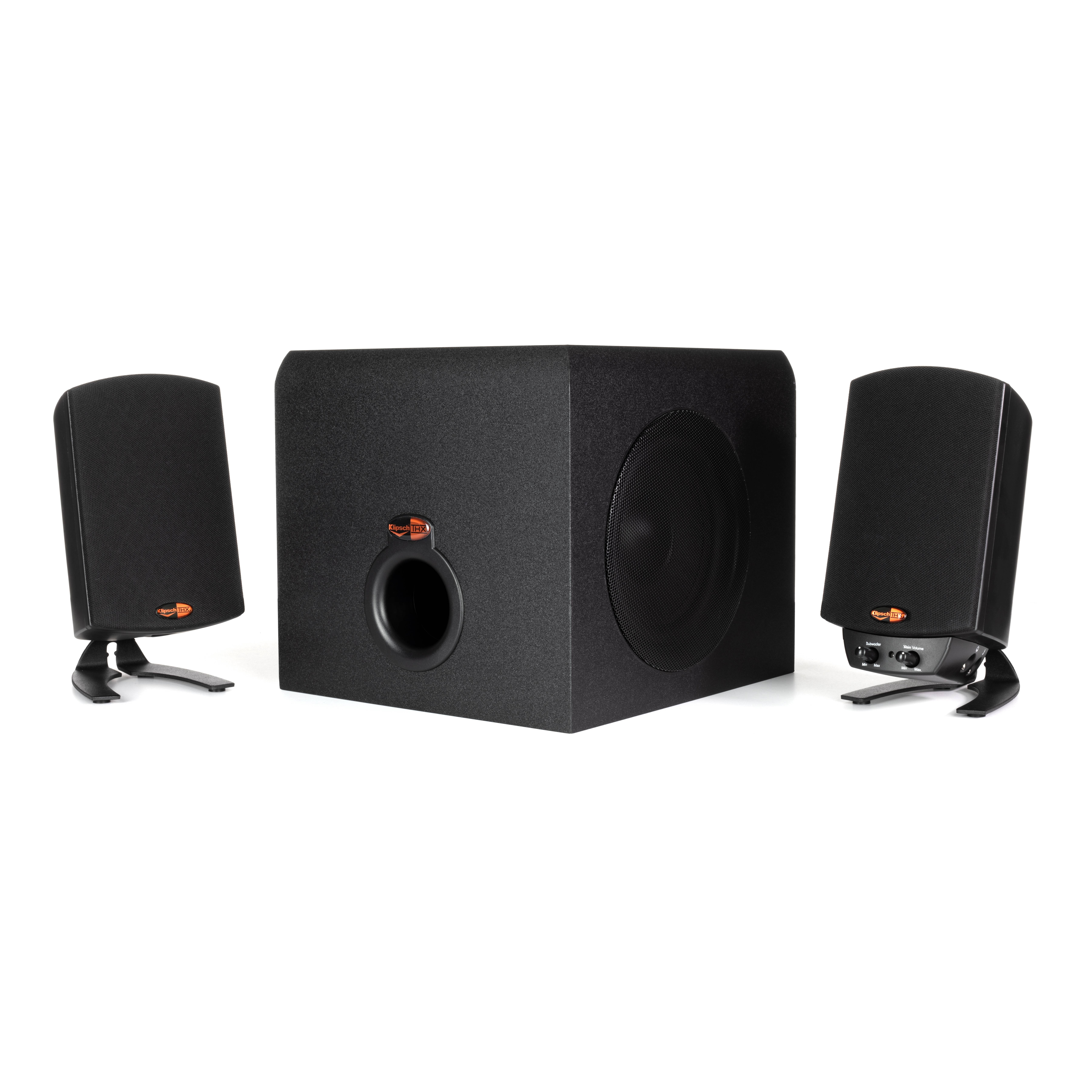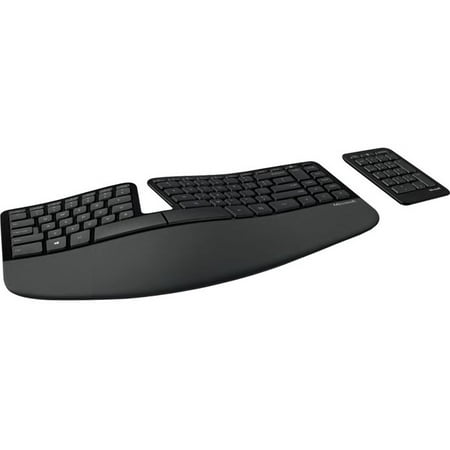Klipsch ProMedia 2.1 THX Computer Speakers; Two-Way Satellites’ 3″ Midbass Drivers and 6.5″ Subwoofer
200 Watts of Dynamic Power. THX® Certified. Two-Way Satellites’ 3″ Midbass Drivers. 6.5″ Subwoofer. Separate Primary and Subwoofer Controls. Fill The Room With Incredible Sound.
Klipsch ProMedia 2.1 THX Computer Speakers; Two-Way Satellites’ 3″ Midbass Drivers and 6.5″ Subwoofer. Your current desktop speaker system isn’t cutting it. It is time to take your games, movies, and music to the next level with the Klipsch ProMedia 2.1 THX® Certified Computer Speaker system.
Legendary Sound From A Legendary Duo. The Klipsch ProMedia 2.1 THX® Certified Speaker System pairs the legendary sound of Klipsch audio with the revolutionary THX experience. THX engineers conduct more than 2,000 tests on every system to ensure it’s of the highest quality and sound performance. Couple that with Klipsch’s proprietary technology and you can fill the room with incredible sound for gaming, movies, or music.
Exclusive Klipsch Microtractrix® Horn Technology.Klipsch MicroTractrix® horns make a major contribution to the ProMedia’s amazing clarity. Their highly efficient design reproduces more sound from every watt of power, controlling the dispersion of that sound and sending it straight to your ears for clarity and lifelike impact no other system can duplicate.
Clean Bass Output At All Volume Levels. The two-way satellites’ 3” midrange drivers blend perfectly with the ProMedia THX® Certified solid, 6.5” side-firing, ported subwoofer for full bandwidth bass response you can actually feel. Coupled with 200-watts of power, the 6.5” subwoofer creates an immersive sound experience where you’ll hear everything, including your opponent when they lose.
Performance Flexibility. With its plug and play setup and convenient 3.5mm input, the ProMedia THX® Certified 2.1 speaker system offers an easy-to-use control pod. That means a fast change to the volume and subwoofer output. If your neighbors get cranky, simply connect your headphones to game quietly.
- 200 Watts of Dynamic Power
- THX® Certified
- Two-Way Satellites’ 3″ Midbass Drivers
- 6.5″ Subwoofer
- Separate Primary and Subwoofer Controls
- Fill The Room With Incredible Sound
- Game Like Millions Are Watching In High Definition
- Experience Movies Or Your Favorite Shows Like You’Re In A Theater Without Leaving Your Couch
- Crystal Clear Sound Even At Top Volume
- One Of The Most Popular 2.1 Speaker Systems Of All Time
Additional information
| Features | 2 Speakers, Subwoofer |
|---|---|
| Count | 1 |
| Audio Feature | Clean Bass Output At All Volume Levels, 2.1 THX® Certified Speaker System, Performance Flexibility, Exclusive Klipsch Microtractrix® Horn Technology |
| Number of Channels | 2.1 |
| Model | 1067415 |
| Audio Power Output | 200W |
| Brand | Klipsch |
| Assembled Product Dimensions (L x W x H) | 13.39 x 20.87 x 14.17 Inches |






by Ivan
I was interested at a price point much higher than I actually paid and was ultimately just putting it off due to other priorities. Well, I moved my other set of speakers and they stopped working so… That was it. Time to shop around again. I found the listing here for about half what I was expecting to pay and on impulse (despite getting my 15 year old Altec Lansing speakers to work again) decided it was time for an upgrade. Notable: The left/right speakers connect with spring clips (you know those little red and black springy things that hold bare wires) which means you decide whether the volume control lives on left or right channel. There’s a lot of extra cord to work with and the bass hits so hard I almost have to turn it off (well, it doesn’t “turn off” so much as turn all the way down). These are a lot clearer than other common computer speakers and if you want lots of boom you’ve got yourself an 8 inch subwoofer to thump around with that’ll make you wish you hadn’t. The satellite speakers are a 3 inch main woofer (not subwoofer, different thing) with a smaller tweeter which you can’t really see (I think it’s a 1 inch plastic cone). These are the kind of speakers you get if you want to upset your neighbors… Or if you don’t want to upset your neighbors but still want to hear your own audio with any kind of clarity. They do both high volume and low volume quite well.
by Austin
When I saw the size of the box at the front door, I knew this system was the real deal. Both speakers and sub are bigger than expected, and this is not at all a bad thing. The set up is easy, and the speaker wires are long enough to be capable of spreading them out. Now for the audio, these instantly blew me away. I set them up, managed the cables, and played a song on spotify. They are perfect for a gaming set up, not too loud, but the perfect balance of audio and base. Cannot wait to get some gaming in with this system!! The price was $150 on amazon, and just below $100 AFTER TAXES. This is a steal for this quality!
by Stephen
I bought this product as a add on in my smokeroom! I’m blown away at the sound quality and simplicity of this product. setup is a breeze, the instructions are simple and the workmanship evolved is absolute stunning. love the products if you enjoy music and love the quality of it this is the setup to buy!
by Dave
These sound great, I just stumbled on these, I was going to buy the Logitech 625s but I like hearing the highs and some reviews said thats where they lacked. I dont think they have a tweeter. Anyway these Klipsch have a complete full sound. I forgot what I was missing. Volume is good and the bass is good and the horn is crisp. I cant believe how much bass comes out of that little 6.5. You can get woofer to distort but good luck on the mids and highs. At high volumes you just adjust the separate bass knob to what it can handle and its all good. Couple things I dont like and they are. Reviews came in say that these didn’t last to long. Well I bought the 3 year warranty for $11.00. The other is that there is no power switch. Once you plug them in the wall they are on till they die. I noticed the built in amp runs a little warm even when not in use. So I figure run them all the time because the air flow that comes out of the bass port is like a fan. When I saw that a believed them when they said it has a long throw woofer. I like them, so far they are the best computer speakers I ever had, and I am 58, thats a few sets. Guess I will put a power strip in somewhere with an on off switch because just leaving something on 24/7 is ridiculous. No Energy Star rating for these. But the sound is kickin!
by Vermonta
These are the best speakers I’ve ever purchased for a computer sound system. Crisp highs, and a terrific subwoofer. Very easy install. And…it arrived a week early! Two thumbs up, 5 Stars.
by Frank
I’m enjoying the sound of these speakers. The bass is good and I have no real complaints with highs or mid range either. Could the sound be better yes, but it’ll cost you more. Cons: power light is always on, you cannot turn the volume knob to an “off” position. speakers are large. Subwoofer would not fit under my desk like my previous set would. satellite speakers are tall and would not fit under my monitors standing up. I ended up laying them sideways under my monitors in order to not block the tweeters with the back of my monitors. The speakers connect into the amp/subwoofer using standard /- wires and you have to push the bare wires in manually. I really wish this was finished with some sort of connector. Pros: I like the sound stage on these. They get loud main volume and subwoofer level are on the same module making it easy to adjust either at the same time. Speaker grilles are detachable (simple push in/non-magnetic)
by Nicole
love the system, but very disappointed about how it was shipped. Shipped in factory box, with no signature required. Tape said no peeking! But box showed what was in it. It was a gift for my bf and was supposed to ve a surprise for christmas.
by Charles
ABSOLUTELY AWESOME!! Clear sound even at the highest volume! Great bass from the sub. I wish the speakers had wood cabinets instead of plastic.